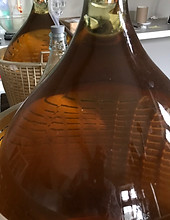How a village made a practically perfect cider,
in a small kingdom by the North Sea.
Our Story
Here it is, exactly as it happened:
In 2014, Russia decided to "annex" Crimea., which was part of Ukraine.
In return, Europe sanctioned Russia, and Russia boycotted European fruit. This included apples from a small kingdom by the North Sea called Belgium. The local news showed good fruit being plowed into the ground, and Wayne, a retired American diplomat, took notice. Hoping to help the farmers in the country he and his family had come to call home, Wayne wanted something good to do with good fruit.


Wayne and his family had settled in a village in Flanders called Imde, near Brussels, where they learned the art of assimilating--mainly by not speaking French to anyone
in Flemish-speaking Flanders.
On arriving in Imde, in true American style, he
bought a big house. Known locally as
the "Kasteel" and shown on the maps as "Imdenhof", the house was chosen by Wayne's English wife, Anna-Marie. She liked it because it was dilapidated but had character, and was suitable
for raising horses--Belgium's second most popular pass-time after fanatical cycling
--and Anna-Marie's passion. Incidentally, Imdenhof was historically the home of a famous orchard of rare fruit trees.
But it was Jos who eventually got the ball rolling. Jos was a friendly neighbour who had
been the first in the community to befriend the newcomers. One morning, like most, over coffee at the kitchen table, Jos caught onto the concept of making cider, which Wayne
had begun to experiment with as a way to use surplus apples.
Everyone in Belgium drinks.
So, two days later Jos dropped off a trailer full of apples. He didn't stay for coffee and Wayne faced threats not worth finding out about if the apples lasted longer than a day
on the driveway.

Over afternoon tea, Anna-Marie mentioned the load of apples to Martine, a low-key Baroness who keeps the beautiful 'De Kam', an idyllic country home tucked along a tree-lined lane across from Imdenhof.

Endlessly resourceful Martine ducked into her cellar and emerged with a complete cider- making kit, including an apple grinder, press and large glass jugs called "dames jeannes" for fermentation. Jos and Wayne had everything they needed to mulch, press and ferment the apples.
Anna-Marie offered lunch for anyone who would help. Koen who lived around the corner showed up and took a turn.


So did Bernard, the son of Martine, and occasional resident of the Cam, who rather likes his coffee breaks.
Another neighbour, Jan, brought more varieties of apples from his old growth trees, and kept them coming.


Roshi who lived next door came to see what
was happening. She soon found herself running the mill.
The cider slept in the Dames Jeannes through the winter and come spring, donations of empty champagne bottles came mainly from Koen's dad Dirk, who claimed to be collecting them from a local restaurant. The cider was blended, bottled and ready to be enjoyed.


The residents of Imde held a street party
each summer, and it was here the cider debuted. Beer-loving Belgians will admit that
Belgium also has a cider-making history. It was the night of the street party that Jos recalled the story of the goose keeper who once lived in the"Ganzenhof", or Goose House, on the Kasteel grounds. From the Ganzenhof, the goose keeper would herd his flock of Flemish geese through the Imdenhof orchards to mow the orchard floor and collect the windfall apples to press and ferment. The cider had found its name - Ganzenhof.
In only a few months of summer, the contents of the cider cellar were consumed, perhaps due to the small quantity rather than the quality at the time. But it was too early in the enterprise for anyone in Imde to be too critical. Instead they offered encouragement. Until the boys came home for the holidays.
Wayne and Anna-Marie's two sons had both taken the Hippocratic oath and as those who would always be forgiven, did not hesitate to point out, well, imperfections in the cider. But they also saw the potential, and encouraged Wayne to travel to England for training at an academy famous for teaching students to make "flawless" cider.


One of the boys' girlfriend had artistic ability
and painted a goose as a gift for Wayne one
weekend. It made its way onto the front label.
It stuck around since.
When Wayne returned from England, hours, days, weeks and months passed with Wayne locked in his cider house. Envelopes of yeast from everywhere from Champagne to Canberra arrived. Tanks and racks were set up in every centimeter of free space.
The annual cider-making ritual continued. Each year, Wayne refined the process. Each year the village came together to create the cider. Thirty litres became
three hundred which became three thousand. Still there was never enough. Wayne's perfectionism and insistence on using traditional methods--double fermentation, careful blending, turning and disgorging the bottles in the same way that champagne is made--took a lot of time. But on any given day in Imde,
someone was ready to help.

So after several years, with final approval of the taste and quality from everyone who had a hand in making it, it was time to start selling Ganzenhof cider, so that others too could try it.

The truth is, all good things take time. But we think it was worth it. We are immodest enough to believe the cider by now is really very good. In fact, we think it's practically perfect.
Ganzenhof cider is still made from local apples
in a tiny village in a small kingdom by
the North Sea, with a big sense of community.
